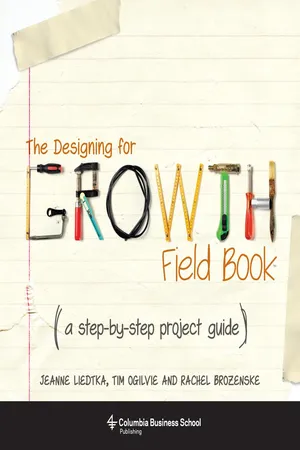
The Designing for Growth Field Book
A Step-by-Step Project Guide
- English
- ePUB (mobile friendly)
- Available on iOS & Android
About this book
In Designing for Growth: A Design Thinking Tool Kit for Managers (D4G), Jeanne Liedtka and Tim Ogilvie showed how design can boost innovation and drive growth. In this companion guide, also suitable as a stand-alone project workbook, the authors provide a step-by-step framework for applying the D4G toolkit and process to a particular project, systematically explaining how to address the four key questions of their design thinking approach.
The field book maps the flow of the design process within the context of a specific project and reminds readers of key D4G takeaways as they work. The text helps readers identify an opportunity, draft a design brief, conduct research, establish design criteria, brainstorm, develop concepts, create napkin pitches, make prototypes, solicit feedback from stakeholders, and run learning launches. The workbook demystifies tools that have traditionally been the domain of designers—from direct observation to journey mapping, storytelling, and storyboarding—that power the design thinking process and help businesses align around a project to realize its full potential.
Frequently asked questions
- Essential is ideal for learners and professionals who enjoy exploring a wide range of subjects. Access the Essential Library with 800,000+ trusted titles and best-sellers across business, personal growth, and the humanities. Includes unlimited reading time and Standard Read Aloud voice.
- Complete: Perfect for advanced learners and researchers needing full, unrestricted access. Unlock 1.4M+ books across hundreds of subjects, including academic and specialized titles. The Complete Plan also includes advanced features like Premium Read Aloud and Research Assistant.
Please note we cannot support devices running on iOS 13 and Android 7 or earlier. Learn more about using the app.
Information
| Question | Design thinking is appropriate if … | Linear analytic methods may be better if … |
| Is the problem human-centered? | Deep understanding of the actual people (users) involved is both possible and important | There are few human beings involved in the problem or the solution |
| How clearly do you understand the problem itself? | We have a hunch about the problem and/or opportunity, but we need to explore and get agreement | We understand the problem clearly and are sure we’re solving the right one |
| What’s the level of uncertainty? | There are many unknowns (large and small), and past data is unlikely to help us | The past is a good predictor of the future |
| What’s the degree of complexity? | There are many connecting and interdependent facets of the problem; it’s hard to know where to start | The path to solving the problem is clear, and analytic methods have succeeded in solving similar problems in the past |
| What data is already available to you? | There is very little relevant existing data to analyze | There are several clear sources of analogous data |
| What’s your level of curiosity and influence? | I’m excited to explore more and can get a group of people willing to help me | The problem feels routine to me, and I have to follow existing processes and systems |

| Design Brief | |
| Project Description | What is the problem or opportunity? Describe the project in a few sentences, as you would in an “elevator pi... |
Table of contents
- Cover
- Title Page
- Copyright
- Using Your Field Book
- Contents
- The Four Questions
- The Steps
- The Tools
- Templates
- Resources
- An Example Project
- Acknowledgments